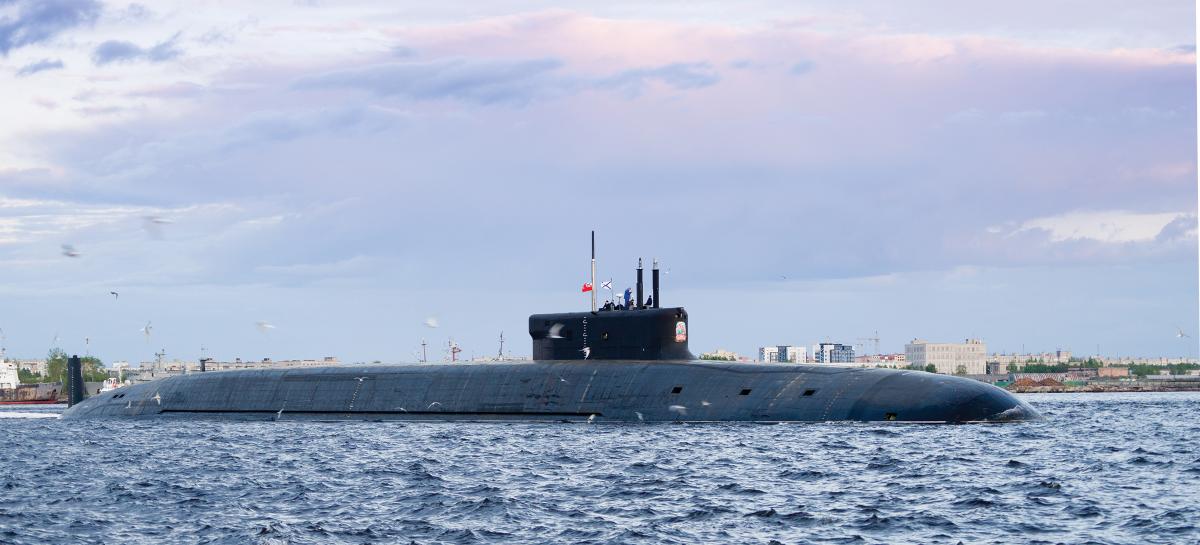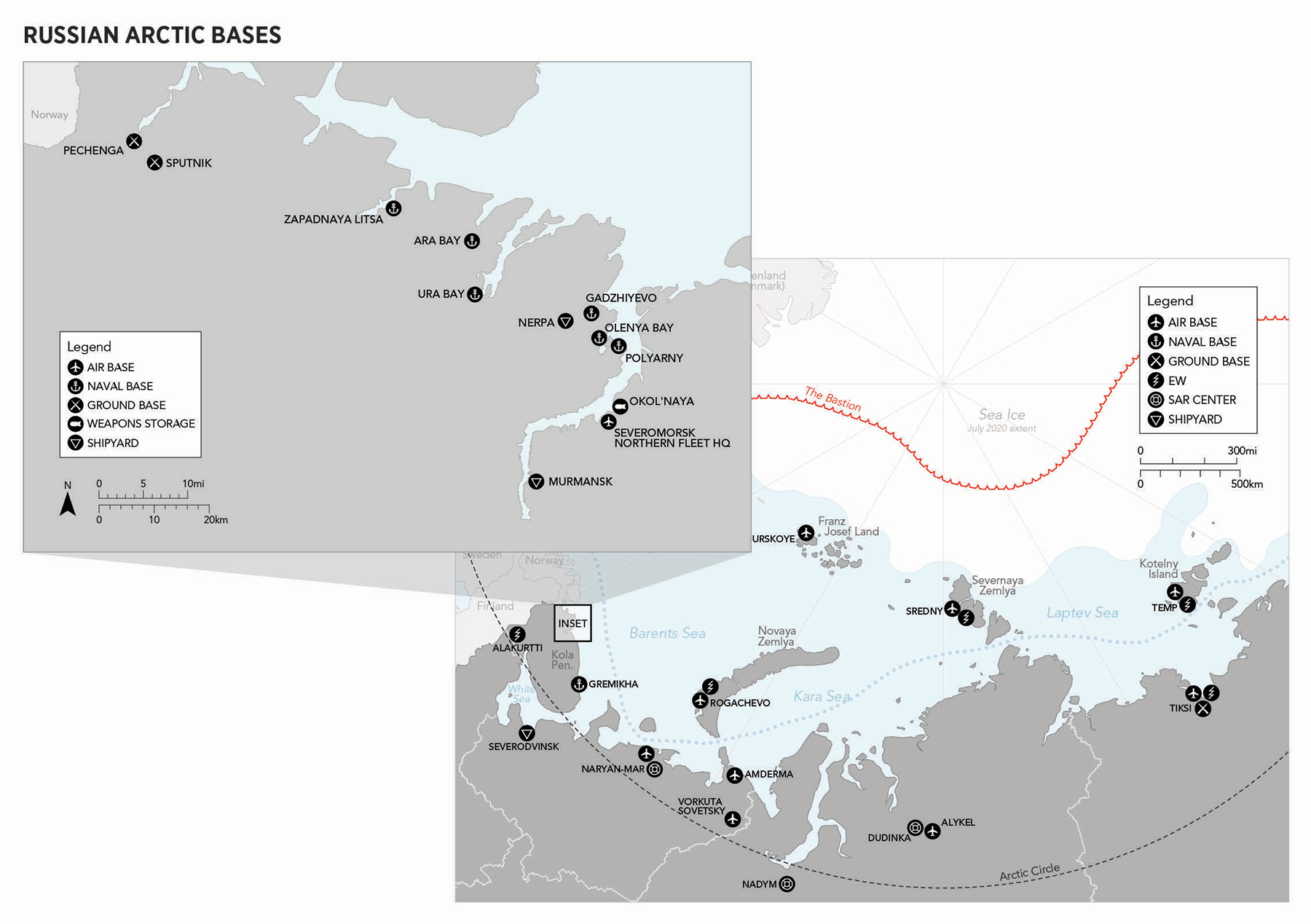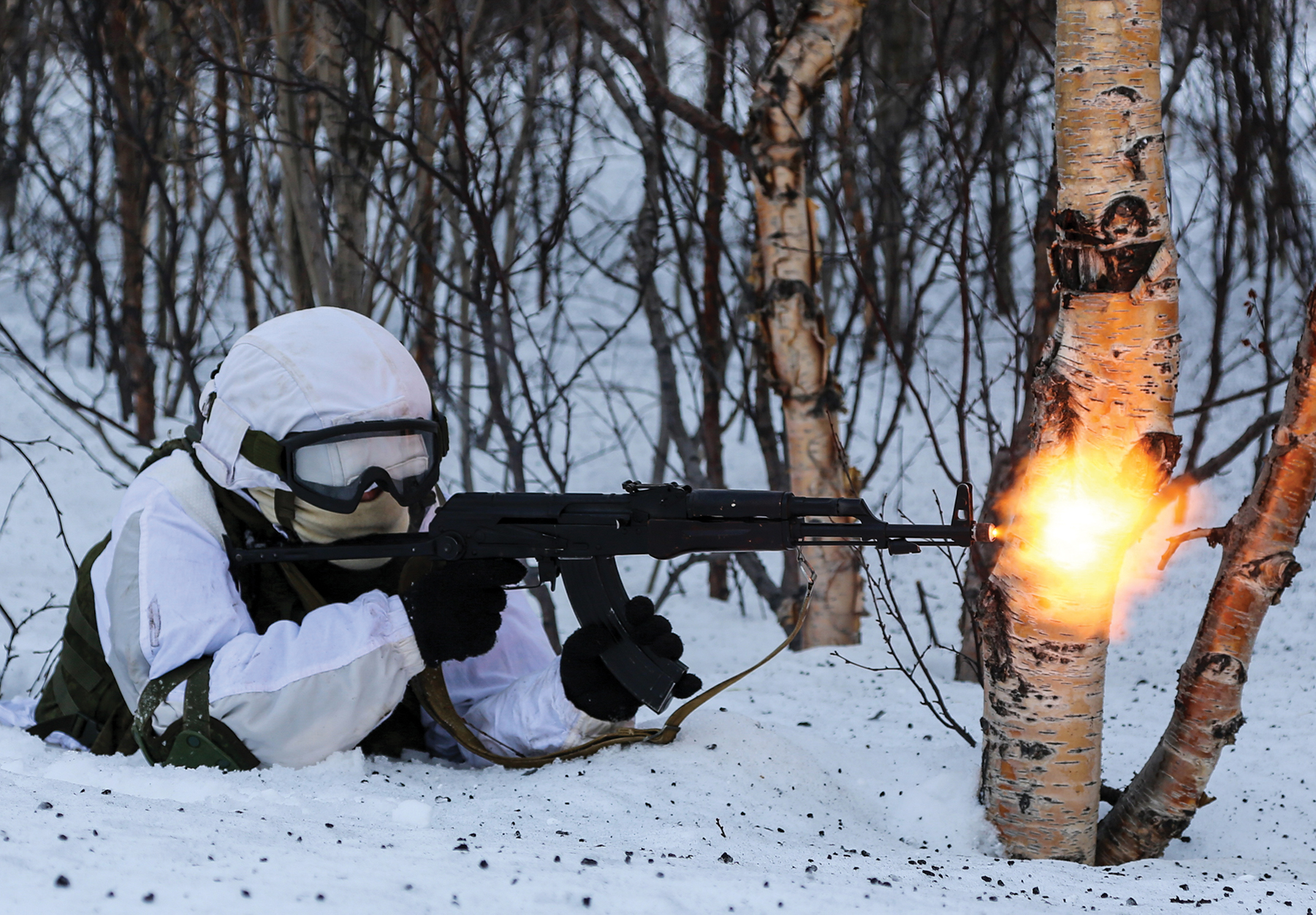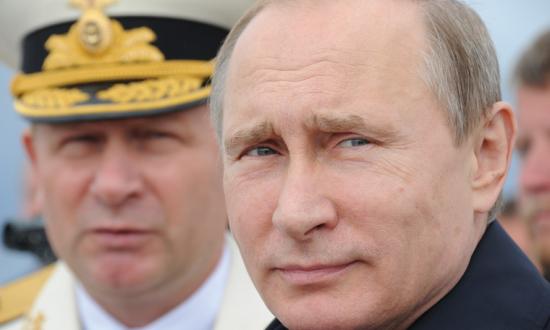Once a fleet of rusting Soviet-era ships largely tied to piers on the Kola Peninsula, the Northern Fleet is the beneficiary of a nearly two-decade effort by Moscow to revitalize the force. Progress has been uneven, with missed production deadlines and certain ship classes shelved indefinitely, but the Northern Fleet today is better organized, equipped, and trained than ever. Elements of the fleet have been battle-tested, and the rest have been assessed in scheduled and snap exercises. It is becoming more competent, confident, and assertive. Close encounters with NATO and Scandinavian allies at sea and in the air reflect a force in transition from a largely defensive posture toward one capable of effective, offensive operations.
For their part, the U.S. Navy and its NATO partners risk losing an opportunity to set and hold a strategic deterrent advantage in the Far North and Arctic. Important facilities have been shuttered and capabilities allowed to sunset.1 As important, study of the Russian way of war and Russian culture and language—basic elements needed to know an adversary—now resides in small groups of experts, mostly in academia and policy research institutes. Without that deep understanding, the West incurs greater risk of finding itself in a strategic conundrum.
The ‘New’ Northern Fleet
President Vladimir Putin’s vision of a return to great power status had a naval component from the beginning. As Professor Mikhail Tsypkin noted, his arrival in 2000 “appeared to open a new and more ambitious era for the Russian Navy.”2 Despite early setbacks, Putin persisted, and on 7 May 2012, he signed a presidential decree that prioritized weapon modernization and development for the Russian Navy, strategic and nonstrategic nuclear weapons, and revitalization of the Arctic. The goal for completion of the bulk of the effort was 2020.3
The ships delivered to the Northern Fleet suffer what Michael Kofman calls “distributed classality”: “building numerous ship classes, in small batches, with similar missions and displacement.”4 Still, the force is modernizing, with a focus on submarines. Last summer, Sevmash Shipyard delivered the first Borei II ballistic-missile submarine (SSBN) Knyaz Vladimir, and Nerpa Shipyard returned the Akula II attack submarine Vepr to service on 5 August 2020, after an extensive overhaul period. The Sevmash-built Yasen-M guided-missile submarine Kazan began acceptance trials last autumn and is expected to join the Severodvinsk in March 2021.5 The Kazan is expected to test and eventually deploy with the new 3M22 Tsirkon hypersonic cruise missile.6 Earlier this year, the lead ship of the Admiral Gorshkov–class frigates test fired the Tsirkon from the Barents Sea, hitting a target in the Urals.7
The world’s largest submarine, the Oscar II Belgorod, was launched in 2019. Based at Olenya Guba on the Kola Peninsula, the Belgorod will be assigned to the 10th Department of the Main Directorate for Deep Sea Research, a General Staff entity not subordinate to the Navy. The submarine will be capable of carrying the Poseidon long-range nuclear-armed autonomous torpedo or serving as mothership for Project 210 Losharik, a deep-diving nuclear-powered “research” submarine.8
Complementing the Belgorod will be a new class of missile submarines expected to be launched at Sevmash this year: Project 09851 Khabarovsk, also expected to carry the Poseidon.9 In total, some 15 nuclear-powered submarines are in various stages of construction at Sevmash.
In addition, effective 1 January 2021, the Northern Fleet gained status equivalent to Russia’s four military districts.10 At first glance, the elevation of a fleet to that of the most senior geographic administrative units of the Russian armed forces appears unprecedented.11 On closer examination, however, it can be seen as the codification of a unique command structure that was assigned to the Northern Fleet in December 2014. At that time, the fleet was designated a joint strategic command with geographic responsibilities carved out of the Western Military District, with ground and air forces subordinated under the then–Northern Fleet Commander Admiral Vladimir Korolev.
Putin’s long-standing interest in the Arctic added a sense of urgency to the new joint strategic command, and larger defense budgets allowed the interservice forces to carry out hundreds of exercises in the intervening years to test the premise of a naval-led joint command. Visits by Putin to observe large exercises telegraphed to the General Staff the need to make what some had considered an experiment in joint command and control a success.12
From the Kola Peninsula East
The Northern Fleet, headquartered at the naval base in Severomorsk, historically was homeported at bases on the Kola Peninsula. Many of those bases have been modernized in recent years, including Gadzhiyevo, where Russia’s Delta IV, Borei, and Borei II SSBNs are based, and Okol’naya Bay, where ballistic missiles and nuclear warheads are maintained and stored.13 Under the new command structure and revitalization program, the fleet’s reach now extends east 2,000 miles to Kotelny Island, where the refurbished Temp Air Base is home to a Sopka-2 radar and defended by Pantsir-S1 (SA-22 Greyhound) surface-to-air batteries and K-300P Bastion-P (SS-C-5 Stooge) coastal defense missiles.14 But base reconstruction is incomplete, with some facilities minimally manned, reflecting budget shortfalls and questions about the return on these investments to the state.
The preponderance of the Northern Fleet’s force structure is naval, with the majority of ballistic-missile and attack submarines based there, as well as major combatants and naval aviation units. Ground forces are modest, but the fact that they are part of the Northern Fleet’s force structure is important. Within the 14th Army Corps are two Russian Army motorized rifle brigades (MRBs): The 80th Separate MRB at Alakurtti (32 nm from the Finnish border) and the 200th Separate MRB at Pechenga (6 nm from the Norwegian border), complement the 61st Naval Infantry Brigade and the 536th Coastal Missile and Artillery Brigade.15 Coastal defense units are being modernized and deployed north and east to newly refurbished bases on remote islands such as Alexandra Land on the Franz Josef Land Archipelago and Kotelny Island.16
Air assets were consolidated under the 45th Air and Air Defense Army in 2015, with two air-defense divisions and six air regiments subordinated. Northern Fleet air attack squadrons completed more than 400 sorties (117 at night) off the carrier Admiral Kuznetsov in 2016–17 against targets in Syria.17 Indigenous air mobility and air refueling are weaknesses in the Northern Fleet’s aviation force structure.18 Otherwise, air and air-defense forces have expanded long-range surface-to-air missile coverage with deployments of S-400 (SA-21) batteries assigned to the 45th Air and Air Defense Army, as well as the Pantsir-S1. Overhead, MiG-31BM interceptors have returned to flying routine patrols over the North Pole for the first time in 30 years.19
These structural changes are essential building blocks of a layered, comprehensive, and credible force capable of defending strategic interests against future threats.
Missions and Doctrine
In addition to its primary missions as protector of Russia’s northern frontier and force provider for out-of-area operations, the Northern Fleet provides and protects the sea-based nuclear deterrent and the bastion and offshore strategic resources, including trade routes (i.e., the Northern Sea Route) and hydrocarbon and mineral deposits in the seabed off the northern coast. While these missions are long-standing, 2017 Russian Navy doctrine signaled a transition from passive defense and deterrence to more aggressive engagement.
The updated doctrine describes the perceived threat environment for the next ten years as unstable, with growing rivalries, including the prospect of U.S. and NATO navies armed with precision nuclear and conventional weapons operating near Russian shores. This is a departure from previous naval doctrine, according to Richard Connolly, who notes the revised threat assessment led to evolved thinking about the role of the navy in the nation’s defense: “Whereas previous versions emphasized the strategic nuclear strike capabilities of Russia’s submarine-based missile forces (SSBNs), the 2017 policy offers a much broader and consequently more flexible statement of the navy’s capabilities.”20
So, while at its core the Russian Navy remains a defensive force, it is transitioning to a green-blue water force of more and smaller surface combatants, armed with long-range precision missiles—both conventional and nuclear—capable of contributing combat power in large theaters of operation. Even more, it is seen as a deterrent force capable of inflicting extensive damage on an adversary.
Accordingly, the way naval forces are employed is in transition. Michael Kofman argues convincingly that anti-access/area denial is not part of the Russian naval lexicon, nor is interdiction of sea lines of communication or the Fourth Battle of the Atlantic.21 Projecting Western doctrine as elements of a Russian way of war prepares the Alliance for the wrong battle and risks missing how the Russian Navy—and Northern Fleet—is transitioning.
The combat successes of the Kalibr (SS-N-30), now carried on a variety of attack submarines and surface combatants, means the “Russian navy today possesses an unprecedented ability to undertake non-strategic nuclear and conventional strikes on land targets,” according to Connolly.22 In particular, “Russian determination to break up the enemy aerospace attack, in which naval platforms would play a major role, suggest[s] the maritime domain as a candidate for early nuclear use for demonstrative or operational purposes.”23 The implications of this evolution in Russian thinking on nonstrategic nuclear weapons deserve in-depth consideration by U.S. Navy and NATO planners.
Reality Check
On a macro scale, however, Russia barely qualifies as a participant in great power competition. The nation continues to experience a declining GDP—from a high of $2.3 trillion in 2013 to perhaps as low as $1.3 trillion in 2020—a reflection of the global pandemic, the 2014 economic sanctions, and its dependence on energy and commodity prices. Rather than driving toward a more diversified economic base, encouraging competition and investment, and addressing endemic corruption, Moscow has sought to build a wall of protectionism. Such insulation affords a certain durability to the Russian economy but is unlikely to change its status as the 11th largest economy by GDP.24
As for weapons, yes, the technical advances that are being rolled into new platforms and weapons pose a challenge. But today’s Russian Navy remains a shadow of its former self. Consider, for example, the Soviet Fifth Eskadra: Based in the Mediterranean, it played a prominent role in Moscow’s military support to clients in the region. During the 1973 Arab-Israeli conflict, “the Soviet navy surged combatant strength from a force level of less than 55 ships (in the Mediterranean) prior to the conflict, to a post crisis high of between 94–98 warships and auxiliaries.”25 Today, the Northern, Baltic, and Black Sea fleets could surge only a fraction of that combat capability. In a recent deployment to the Mediterranean by a Baltic Sea detachment, the three-ship group consisted of a Steregushchiy-class corvette, a Kola intermediate sea tanker, and the oceangoing tug Yakov Grebelsky.26 Tugs now regularly support blue-water deployments—a reflection of maintenance and logistics challenges.
All this to say, the pace and status of Russia’s post-Soviet rearming is complex, uneven, and in some ways uncertain. That does not mean the West can rest easy.
The U.S. Navy and NATO’s Response
To their credit, the United States and NATO have responded with, among other things, more frequent naval excursions into the Barents Sea and regular deployments to the region by maritime patrol squadrons. But to keep pace with the expanding threat, more is needed to temper Russian adventurism in places such as the Baltics. Improvements in the following areas are recommended:
Understanding of the Northern Fleet’s capabilities, intent, and context. Several questions remain unanswered: Can and will Moscow complete military and commercial infrastructure projects in the Arctic? Will ambitious shipbuilding goals be met?
Improved positioning of intelligence, surveillance, and reconnaissance assets—from U.S. maritime patrol aircraft based in Iceland, the United Kingdom, and Norway to fixed land and seabed-based surveillance systems and space-based government and commercial systems—is vital to maintaining situational awareness of Northern Fleet capabilities and intent. NATO’s acquisition of the RQ-4D Air Ground Surveillance system is a positive development, as is the formation of the Joint Intelligence and Security Division at NATO Headquarters. Still more needs to be done to improve U.S. and NATO interoperability.27
Refreshing the study of Russian military strategic thought at universities and service schools will help naval officers better understand their Russian counterparts and how they intend to fight at sea. And a resumption of regular navy-to-navy talks—as challenging as they will be—could improve understanding of each other’s intent and thereby reduce uncertainty and misinterpretation when tensions are heightened.
Force structure. The U.S. Navy teamed with its NATO and Scandinavian allies holds several advantages over the Russian Navy, but those advantages do not guarantee victory should conflict arise. Dominance in undersea warfare, longer-range missiles, and superior air power may prevail in a battle of the first salvo, but certain vulnerabilities, such as early disruption of C4I systems or a mission kill of a single high-value platform, could compel a U.S. strike group to cede a theater of conflict to a Russian challenger. Larger numbers of smaller, well-armed surface combatants, manned and unmanned, could improve resilience in a fast, hard, war-at-sea scenario.28
Organizing NATO’s sea services to influence, deter, and, if necessary, engage the Northern Fleet would be well-served by a standing Combined Maritime Force Atlantic.29 A dedicated multinational force focused on deterring operations by the Northern Fleet would contribute to stability and peace in the Euro-Atlantic theater.
Naval nonstrategic nuclear weapons. The General Staff and Russian operating forces view nonstrategic nuclear weapons employment as a continuum, within which a decisive outcome must be achieved or a strategic signal conveyed. This is fundamentally about options—and they have elected to give themselves more of them. Further, Hans Kristensen and Matt Korda note: “As far as we can ascertain, the biggest user of non-strategic nuclear weapons in the Russian military is the navy, which we estimate has an inventory of approximately 820 warheads for use by land-attack cruise missiles, anti-ship cruise missiles, anti-submarine rockets, anti-aircraft missiles, torpedoes, and depth charges.”
As such, U.S. and NATO sea services may not know if, when, or how an engagement with a Northern Fleet element could go nuclear. This is a departure from Western considerations of the utility, efficacy, and morality of nuclear weapon employment and is an argument for deeper understanding of Russian nuclear doctrine and formulation of a Western way of war at sea in a nuclear context. This is not an argument for nukes on NATO ships. Rather, it is a call for a clear-eyed understanding of what the future could hold, in part to dampen the strategic military and psychological advantage such an attack might afford a challenger, and to consider questions such as: How do rules of engagement change in a nonstrategic nuclear weapons context? Could Atlantic Alliance sea services disaggregate in the face of a nuclear attack at sea? How is the deterrent value of increased Western naval operations in the Far North—and in or near the Bastion—calculated?
Embrace the new Arctic strategy. The 2021 A Blue Arctic: A Strategic Blueprint for the Arctic reflects the U.S. Navy’s developing interest in the Arctic as a domain.30 It acknowledges the changing climate and northern environment and lays out three objectives that will support U.S. national security interests: “maintain enhanced presence; strengthen cooperative partnerships; and build a more capable Arctic naval force.”
The U.S. Navy, Air Force, and Department of Defense all have published updated strategies for the Arctic in recent years. They are both a request for resources and an assurance that the services take the Arctic domain seriously, but they also reflect the lack of a broad, coordinated national approach to the Arctic. Blue Arctic reflects the service’s recognition of the challenges that lie in the Far North, including the military challenge posed by the Russian Navy. Until a broader, more comprehensive strategy is in place, this is the approach the Navy staff and the fleet should embrace.
Increase Arctic surface operations. If the United States and NATO intend to protect their interests in the Arctic, they need to be able to operate there safely and effectively. A freedom of navigation operation via the Northern Sea Route is currently aspirational: A long, dangerous, and unfamiliar waterway with only the Russians for backup is too risky. Setting a goal now that someday ice-capable ships and ice-capable sailors will make that voyage on a regular basis is how to get there. In the meantime, shorter forays into the Arctic will condition both sides to such operations and will allow more opportunities to observe and better understand Northern Fleet naval and coastal forces in the Arctic.
A Sense of Urgency
The Northern Fleet is a capable, credible force that will continue to improve and expand in the years ahead. It is a force that the allied sea services could face during the next Russian move against shared Western interests. The United States and NATO can blunt the Northern Fleet’s challenge, but there is urgent work to do.
It is possible that someday there will be an opportunity for more closely aligned interests between the West and Russia, a nation with a proud history of achievement in science, technology, industry, and the arts. Allowing the Russian populace to flourish and prosper as members of a broader community of like-minded nations should be a long-term goal of the Atlantic Alliance. Regrettably, that time may not come during the Putin era, and so, for now, the navies of the United States and NATO must stand ready as guardians of Western interests to respond to the challenge of the Northern Fleet.
1. VADM James R. Fitzgerald and RADM Richard F. Pittenger, USN (Ret.), “ASW: Will We Ever Learn?” U.S. Naval Institute Proceedings 145, no. 4 (April 2018).
2. Mikhail Tsypkin, “The Challenge of Understanding the Russian Navy,” in The Russian Military Today and Tomorrow: Essays in Memory of Mary Fitzgerald, Stephen J. Blank and Richard Weitz, eds. (Strategic Studies Institute, U.S. Army War College, July 2010), 331–58.
3. Vladimir Putin, “Decree from the President of the Russian Federation on Implementation of Plans for the Construction and Development of the Armed Forces of the Russian Federation, Other Troops, Military Formations and Bodies and the Modernization of the Military-Industrial Complex,” No. 603, 7 May 2012.
4. Michael Kofman, “Shipbuilding Updates from Russia’s Naval Salon (MBMC-2017),” Russian Military Analysis blog, 9 July 2017.
5. Thomas Nilsen, “Nuclear-sub Builder Sevmash Now Has 30,000 Employees,” The Barents Observer, 9 December 2020.
6. H. I. Sutton, “Russian Navy to be First to Field Hypersonic Cruise Missiles on Submarines,” Forbes, 15 September 2019.
7. TASS, “Russia Test-launches Tsirkon Hypersonic Missile from Ship for First Time,” 27 February 2020, https://tass.com/defense/1124339.
8. Michael Kofman, “Fire aboard AS-31 Losharik: Brief Overview,” Russian Military Analysis blog, 3 July 2019.
9. H. I. Sutton, “Russia’s Newest Submarine, Khabarovsk, Could Redefine Underwater Warfare,” Forbes, 9 June 2020.
10. Vladimir Putin, “Decree from the President of the Russian Federation on the Military-Administrative Division of the Russian Federation,” No. 374, 5 June 2020.
11. Thomas Nilsen, “Putin Heightens the Strategic Role of the Northern Fleet,” The Barents Observer, 8 June 2020.
12. Roger McDermott, “Moscow Plans to Upgrade the Status of the Northern Fleet,” Eurasia Daily Monitor 16, no. 58 (24 April 2019).
13. See Heather A. Conley and Joseph S. Bermudez Jr., “The Ice Curtain, Modernization on the Kola Peninsula, a Center for Strategic & International Studies Brief,” 23 March 2020; and Thomas Nilsen, “Is This Russia’s New Coastal Base for the ‘Doomsday Nuke’ Drones?” The Barents Observer, 26 January 2021.
14. Nurlan Aliyev, “Russia’s Military Capabilities in the Arctic,” International Centre for Defence and Security, 25 June 2019.
15. Thomas Nilsen, “Russia Deploys Missile System 70km from Norway’s Vardø Radar,” The Barents Observer, 7 August 2019.
16. Vladimir Isachenkov, “Russia Revamps Arctic Military Base to Stake Claim on Region,” Associated Press, 4 April 2019.
17. Russian Ministry of Defense, “NF Carrier-based Aircraft and Helicopters Began Flights from the Admiral Kuznetsov Heavy Aircraft-carrying Cruiser to the Airfield in Severomorsk,” 2 March 2017, https://structure.mil.ru/structure/okruga/north/news/more.htm?id=12110822@egNews#txt.
18. Mathieu Boulègue, “Russia’s Military Posture in the Arctic Managing Hard Power in a ‘Low Tension’ Environment,” research paper, Chatham House, The Royal Institute of International Affairs, June 2019, 19.
19. Frédéric Lasserre and Pierre-Louis Têtu, “Russian Air Patrols in the Arctic: Are Long-Range Bomber Patrols a Challenge to Canadian Security and Sovereignty?” Arctic Yearbook 2016, 305–14.
20. Richard Connolly, “Document Review: Fundamentals of the State Policy of the Russian Federation in the Field of Naval Activities for the Period until 2030,” Russian Studies Series 2/19, NATO Defense College, 22 January 2019, www.ndc.nato.int/research/research.php?icode=574#_ednref17.
21. Michael Kofman, “It’s Time to Talk About A2/AD: Rethinking the Russian Military Challenge,” War on the Rocks, 5 September 2019.
22. Connolly, “Document Review.”
23. Dave Johnson, “Russia’s Conventional Precision Strike Capabilities, Regional Crises, and Nuclear Thresholds,” Livermore Papers on Global Security No. 3, February 2018, 70, https://cgsr.llnl.gov/content/assets/docs/Precision-Strike-Capabilities-report-v3-7.pdf.
24. The Economist, “Russia’s Economy Is Isolated from the Global Rout,” 26 March 2020.
25. Gordon H. McCormick, “The Soviet Presence in the Mediterranean,” RAND Corp., P-7388, October 1987.
26. “Russian Naval Detachment Calls at Syria’s Tartus,” TASS, 9 January 2021.
27. Artur Gruszczak, “NATO’s Intelligence Adaptation Challenge,” Globsec, 2018-03, www.globsec.org/wp-content/uploads/2018/03/NATO%E2%80%99s-intelligence-adaptation-challenge.pdf.
28. See Joshua Tallis, “To Compete with Russia and China at Sea, Think Small,” Defense One, 12 May 2020.
29. VADM Andrew Lewis, Commander Second Fleet and NATO Joint Force Command for the Atlantic, noted that a Combined Maritime Force Atlantic was proposed to U.S. Navy leadership in early 2021. See AEI webcast, “Defending the Seas: Gray-zone Threats in the Maritime Domain,” https://youtube/SK4lS1jjTFg.
30. Chief of Naval Operations, A Blue Arctic: A Strategic Blueprint for the Arctic, 5 January 2021.







